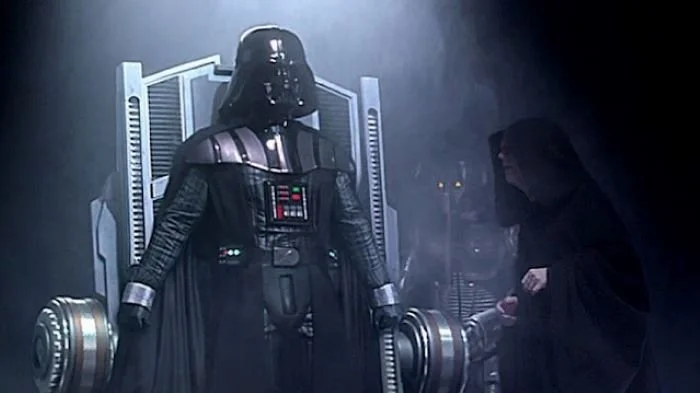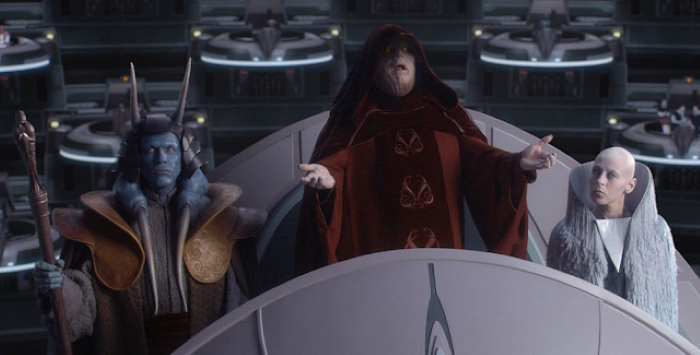Top WOW Moments In The ‘Star Wars’ Prequels: Part 3
I prepared for The Rise of Skywalker’s release by rewatching all the Star Wars movies. I had seen them all when they were first released, and then again when they went to DVD, then Blu-ray. This time, however, I had time and distance with me, and the sequel trilogy as comparisons to how people other than George Lucas did things.
Revenge of the Sith was the movie that surprised me most. It had so much going on that it could have been its own trilogy. It also felt like this was where everybody was finding their feet. Hayden Christensen was criticized for his acting in Attack of the Clones, although I think arguably he was given too many emotional shifts to portray. On the other hand, in Revenge of the Sith, he not only looked the part, but played it with much more assurance and confidence.
So concluding my list …
RELATED: 10 Reasons Revenge of the Sith Is The Best 'Star Wars' Movie
3. Order 66 – Revenge of the Sith
Again, criticism of elements of this scene are petty, such as the use of “Order 66.”
To go off on a tangent, this is a nifty plan. Palpatine initiates the creation of the clones, and ensures that Order 66 is programmed into them. He allows the Jedi to co-opt the clones, gets them to become the Republic’s popular army, then turns them.
Breaking that down, if the Republic had a droid army, it might be programmed to remain loyal the Republic, rather than the Empire. It might also require widespread reprogramming to flip. If the Republic had a typical army, there was always the chance that they would revolt against Palpatine's ascension to emperor, and the Republic’s transformation into an empire. The armies would also be where the power genuinely lies. If they do not support whoever is in charge, then their reign is going to be short. Instead, you have this mindless clone army that has been grown, programmed, and fast-tracked from birth, and all part of the long game that Palpatine is playing. When he moves, they will be ready.
The opposition is the Jedi, this independent body with powers. Whereas other television properties follow how the Empire hunt down the few remaining Jedi, in Revenge of the Sith George Lucas decides to give us a Godfather-esque simultaneous elimination of Palpatine’s enemies.
A lot of heady stuff happens. Anakin kills a bunch of kids. One teen Jedi offers a brief resistance against the clone troopers before he is gunned down while others are systematically murdered. Lucas also gives us Yoda’s reactions as he senses all this happening as John Williams’s moving and tragic score plays in the background.
Some might complain that the Jedi are eliminated too easily. Should they have sensed the danger? I would argue that the Jedi can sense emotion, and that the clones are programmed to emotionlessly follow orders. There is nothing there for the Jedi to read as a threat to themselves (unless they are also meant to be able to read thoughts).
It is also important to recognize that the Jedi are ambushed. Ki-Adi (the Jedi with the big head) briefly deflects blaster shots, but is quickly overwhelmed. It shows that the Jedi also have limitations.
If there is one complaint to be had, it is that it would have been nice to get to know some of these Jedi. We see them in council throughout the prequel trilogy, and in action in the arena in Attack of the Clones. However, we are not given much opportunity to develop an emotional investment in them.
Visually and audibly, this is an epic montage.
2. Anakin BECOMES Darth Vader – Revenge of the Sith
Once Darth Vader was revealed to be Anakin Skywalker in The Empire Strikes Back, speculation was rife about just how he got to be in the suit. I had always assumed it had been a gradual metamorphosis. As he hunted Jedi, he endured wounds that required prosthesis until he systematically lost his humanity and was rebuilt in the suit. George Lucas opted for an immediate transformation, a result of a single fight with Obi-Wan.
While Ewan McGregor and Hayden Christensen should be lauded for the work they put into their swordplay, I am not a big fan of their battle on Mustafar. Yes, it does have great moments, but it is too overplayed. For example, having them precariously balanced on flotsam in the lava river.
Of course, there is the “higher ground.” Darth Maul had the higher ground over Obi-Wan. Is this a contradiction or did Obi-Wan learn something from it? In Return of the Jedi, Luke, standing at the top of a stairway, has the higher ground over Vader. Is this meant to mirror this scene? As it is, you would imagine Anakin could leap ten feet to his left or right. Although understandably he is meant to be so arrogant that he believes he will be able to leap right over Obi-Wan.
Then, Obi-Wan just leaves him burning on the bank and picks up his lightsaber— the lightsaber he would give to Luke in A New Hope, saying his father wanted him to have it. There is so much more that could have been done here. Surely, there could have been an earlier scene where Anakin remarks if anything happens to him, he wants his son to have his lightsaber, or he could have left behind a lightsaber as a keepsake, and built a new one – a red one.
Also, why does Obi-Wan just leave him there? Why not thrust a lightsaber through his head? It would not end the Empire, but it would dint it. The argument might be that Obi-Wan decided Anakin was going to die anyway, but it is merciless to just walk off and leave your former charge to slowly and agonizingly burn.
There are a lot of questions over the way this battle is framed and how it ties into anecdotal canon from the original trilogy. On the other hand, I do think the transformation scene is brilliant. The medical droids repairs Anakin as if he was just a machine himself. Christensen displays terror as the mask comes down on his face. He is being entombed in his choices. This will trap him forever. The mask locks into place. Cue breathing. Here is the Vader we know. He is born.
Despite everything Anakin has done—almost murdered his wife, betrayed the Republic, killed Younglings—you feel an instant of pity. The cot slowly elevates Vader into frame. The room looks like some mad scientist’s laboratory, no doubt a callback to those movies that inspired Lucas growing up.
Then, Vader and Palpatine have an exchange about Padmé. I was not sure how to reconcile Palpatine’s lie that Vader killed her given that it could, and would eventually, be exposed. Surely, this is something that the Obi-Wan Kenobi series will explore. If Padmé had died right there, how does the twins survive? How does Anakin feel about Palpatine lying?
Vader becomess enraged at this reality. He breaks free of the manacles. He is uncoordinated, struggling with his new body. His rage implodes everything around him. The cry of “Noooo” is another callback to those movies that inspired Lucas, as well as a link to the revised Return of the Jedi when Vader cries out “Noooo” as Palpatine is killing Luke. This whole section has a horrific majesty about it, which is both underrated and underappreciated.
While it is unclear if his monster face is some true form that has been hidden beneath a humanoid guise, or if it’s a result of injuries from his battle with Mace Windu, Palpatine embraces it. Anakin recoils from recoils from what he becomes, but is left without a choice if he is to survive. He must be this thing.
It is such a brilliant contrast to how the original trilogy portrays Vader, a true subversion of expectations. In A New Hope, you think Vader is just this superbad. The Empire Strikes Back gives us a fleeting glimpse of his naked burned skull so that we realize he is maimed. In Return of the Jedi, Obi-Wan says, “He’s more machine now than man.” In a galaxy that can replace limbs, we learn Vader has been rebuilt.
Here, in Revenge of the Sith, we see he has not just been rebuilt. He has been incarcerated in this suit. He has surrendered his love for power. While he is indeed powerful now, he can never again know another person’s touch, feel a breeze on his face, or all those things we have poets waxing lyrical about. He must forever be this thing, a testament to his choices. You can totally believe he would become the monster who terrorizes the galaxy out of self-loathing, rather than the pursuit of power, and who only considers redemption when he sees that his son is about to suffer the same fate as Padmé, a victim of the dark side.
1. “This Is How Liberty Dies – With Thunderous Applause” – Revenge of the Sith
This is the prequels’ crowning moment— when Palpatine seizes absolute control and transforms the Republic into the Empire.
Some might criticize the journey Palpatine has taken to get here. Is it too complicated? Is it too unbelievable? Regardless of the scrutiny of each step, you can see how he has incrementally gained power through each crisis, culminating now in his address to the senate.
He gives a rousing speech. Padmé and Bail Organa look on in disbelief. However, you can imagine that the senators, sickened by the ongoing war, blindly put their trust in their leaders to end it. You don’t have to look any further than today's climate to see that the masses will often unquestionably invest their trust in anybody who offers any solution.
The biggest query is whether the senators would believe the Jedi are part of some conspiracy. I don’t think this is the stretch. After all, the Jedi has been depicted as detached from the rest of the populace throughout the prequels. We only see them genuinely interact with the public on one occasion when Obi-Wan and Anakin pursue the assassin in Attack of the Clones. Even here, they demonstrate a level of dismissiveness. They operate autonomously, outside the Senate, and come across as aristocratic. Would it really be hard to believe that most people, who, in all likelihood, have never had any dealings with the Jedi, could suspect them of a plot? Look at distrust today in governments and bodies of power.
I believe Palpatine’s ascension here works. It is also gratifying how Lucas structured it. He could have made Palpatine some dark and destructive force who blustered his way to power. Instead, we get this careful and deliberate politician who constantly manipulates events not only to his advantage, but so that he engenders the support of all and sundry.
Only Padmé and Bail Organa are incredulous.
“This is how liberty dies,” Padmé says. “With thunderous applause.”
It is a beautiful dichotomy that the senate is unwittingly endorsing a descent into tyranny.
This might not be a wow WOW moment, but it is seriously cool nonetheless.
READ NEXT: ‘Secrets of the Sith’: A Review Of Palpatine’s Work




